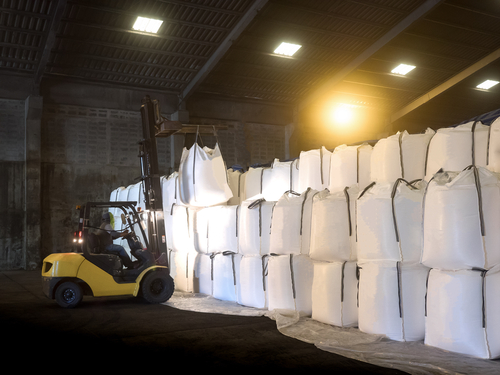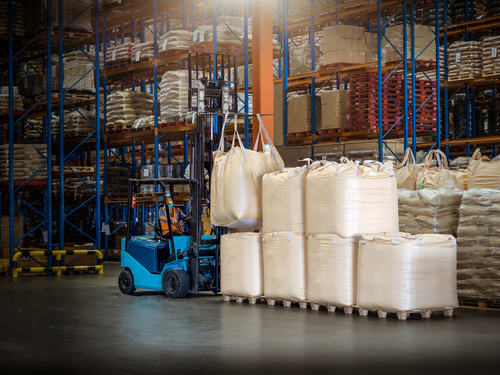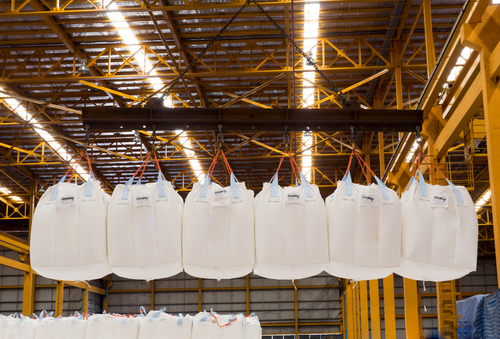Bulk bags or super sack bags have jumped in popularity in recent years. Companies across a wide range of industries are switching out their plastic bins and oversized boxes for large, bulk bags that can store thousands of pounds of dry goods like seeds, grains and prescription pills.
But as these bags grow in popularity, companies need to be aware of the potential dangers of using these bags. Unlike boxes or totes, super sacks tend to move in unpredictable ways, which can be a cause for concern when they weight over two tons.
Learn more about how to stay safe when using super sacks in your facility.
Pay Attention to the Bag Tag
Every super sack should come with its own bag tag, a plastic label that shows you the dos and don’ts of using these bulk bags. Every bag tag comes with visual imagery showing how to properly load and unload the bag. The tag will also list important handling information such as the maximum capacity of the bag, how it should be stored and how to properly seal the bag. This information should always be top of mind when someone’s using the bag in any way.
Protecting Yourself from Static Electricity
Pouring thousands of pounds of dry goods into a bag can lead to a burst of static electricity. Loading or unloading the bag can release all that untapped energy at once, which could even cause the bag to explode if you’re using it to store combustible materials. That’s why you need to completely ground the bag and your equipment when loading or unloading the contents of the bag. You can also use conductivity instruments to prevent incidents like these and keep your work environment safe.
Supporting the Bag
You should always properly support the bag when loading and unloading. Dumping out the bag too quickly can lead to a rush of static electricity or cause the bag to move or sway in unpredictable directions, which could crush one of your employees if you’re not careful. It’s best to use a structural support such as a filling station when loading or unloading the bag to make sure it’s firmly rooted to the ground the entire time.
Check Your Bag-Lifting Equipment
With some super sacks weighing as much as two tons, you’ll need a forklift to move one of these hefty bags. Typically, most facilities will secure the bulk bag to the forklift using a series of ties and straps connected to the bag. The lift should be directly pulling the straps simultaneously to make sure the bag is properly supported and won’t fall unexpectedly. You also need to keep your bag-lifting equipment in proper condition. Forklifts should be routinely inspected to make sure they’re up to the task at hand.
Storing Bulk Bags
Storing super sacks is relatively easy, but there’s still plenty of room for errors. These bags come with nontraditional dimensions that will change based on what’s inside and how they are filled. If you stack these bags on top of each other, you have to make sure they’re stable. All your bags should be thoroughly inspected to make sure they won’t pop open. If one of your bags springs a leak, it could topple over and turn your storage facility into a hazard.
Bags should only be stacked on top of each other if they have stable dimensions and are in good condition. It’s best to use a pyramid stacking structure instead of putting the bags directly on top of each other. Avoid stacking bags that are less than full, contain odd-shaped materials or might need to be repaired. If improperly stacked bags start toppling over, one of your employees could get caught in a landslide, which could easily turn into a devastating mishap.
It is possible to store loaded bulk bags in Flow Rack and Drive-in racking too. If you need lots of raw materials storage, nothing beats these types of racks from a storage density standpoint. Some key factors to keep in mind if you’re using racking:
- Ensure you account for extra space on each side of the bag – Bolts in the racking and other steel components could grab a loop or cut a bag during loading and unloading. The amount of extra space would be on a case-by-case basis and based on the amount of sagging observed in the load. You’ll want extra space on each side and vertically just to account for the variance observed in bag dimensions when they are loaded with product.
- Make sure your slave pallets are up to the task – If you’re storing these bags in Drive-In racking, the pallet used to hold the bag will need to be rated for a “Racking Capacity” that is greater than the load weight. All of our New Rackable Pallets are categorized on this website and rackable pallets have a racking capacity.
- Train your operators – Mistakes are costly particularly with a ripped bag and spilled product, make sure forklift operators are trained to watch closely and pay close attention to loading / unloading procedure to avoid damage to the bags and product.
If you need racking to store your Bulk Bags – Container Exchanger can help – we offer the pallets and racking to accomplish this task.

Reusing Bulk Bags
While most bulk bags are designed to be used more than once, you need to be careful when refilling these bags. Keep a copy of the user’s manual on hand to make sure your bags are designed for reuse. They should have support strings on the top that can last several loads. These bags also tend to have a greater capacity limit than other types of bulk bags. Look for holes, rips or worn edges and other trouble spots before refilling the bag.
There’s a reason people are stocking up on super sack bags. They’re versatile, reliable storage containers that can store massive loads without breaking a sweat. But if your facility is thinking of adopting bulk bags, make sure everyone on your team is aware of these safe handling requirements.

